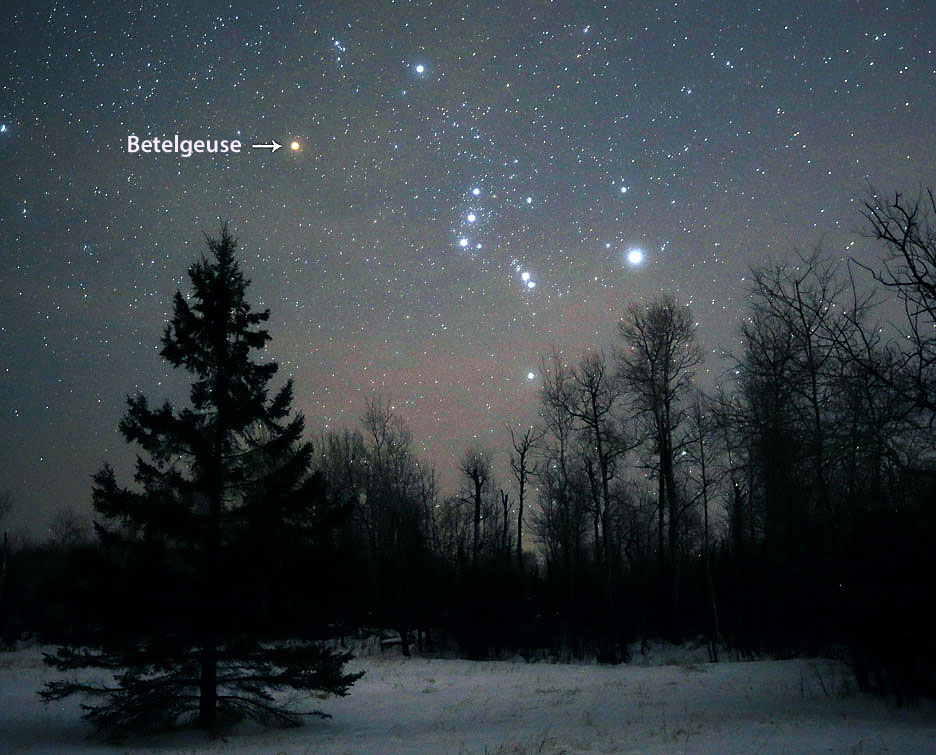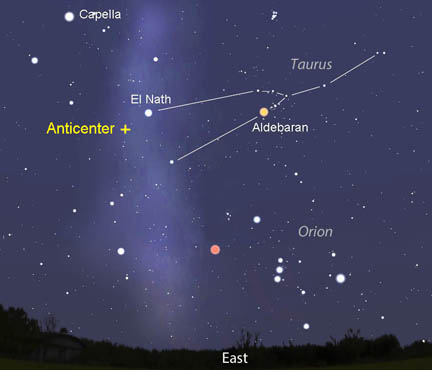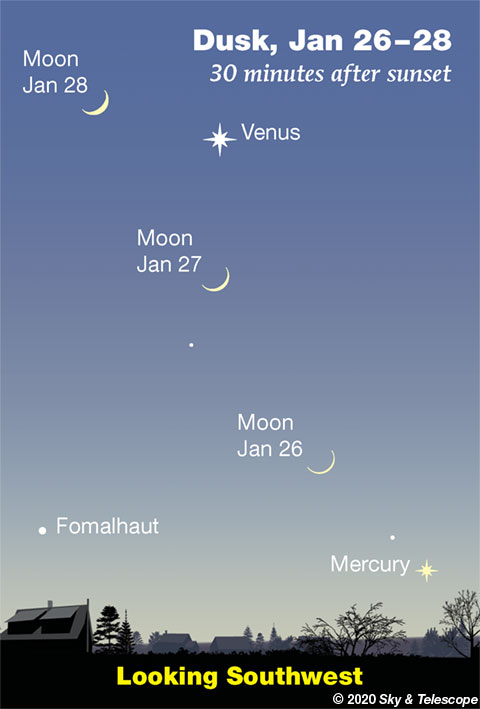
Betelgeuse remains dim. The red supergiant Betelgeuse in Orion's shoulder has always been slightly variable, but for the last month or so it's been in an unusually low dip. As of January 28nd it was still V magnitude +1.6 instead of its more typical +0.5, according to observations logged by the American Association of Variable Star Observers (AAVSO). It clearly looks fainter than similarly-colored Aldebaran, magnitude +0.9, with which it's often compared and normally outshines quite obviously.
Go look! If you're familiar with Orion, he looks distinctly odd with his two shoulders now basically equal. The other shoulder is bluish-white Bellatrix, visual magnitude +1.6, but that's a poor comparison star because of its very different color. As you age your eye lenses yellow, so older people see the world through yellow filters. Thus they will judge the brightness of an orange-red star, compared to a blue-white star, somewhat differently than young folks do. I'm 68, so I see Bellatrix looking a trace fainter than Betelgeuse even though (as of January 28th) their V magnitudes are the same.
Orion this winter wears an aspect you've never seen before and may never again! Read Bob King's new The Latest on Betelgeuse, Plus a Bright Supernova and New Comet Iwamoto
And no, this does not mean Betelgeuse is about to go supernova, despite the hype. Yes, it's a massive star close to the end of its 10-million-year lifespan — but on an astronomical timescale! Expect to wait maybe another 100,000 years for it to violently gulp down its core and blaze, for a few weeks, as bright as the Moon.
Friday, Jan. 24
• Right after dark, face east and look very high for bright Capella, the Goat Star. To the right of it, by a couple of finger-widths at arm's length, is a small, narrow triangle of 3rd and 4th magnitude stars known as "the Kids." Though they're not exactly eye-grabbing, they form a never-to-be-forgotten asterism with Capella.
• New Moon (exact at 4:42 p.m. EST).

Saturday, Jan. 25
• Is your sky dark enough for you to see the winter Milky Way? In mid-evening now it runs vertically up and across the zenith: from Canis Major low in the southeast, up between Orion and Gemini, through Auriga and Perseus almost straight overhead, and down through Cassiopeia, Cepheus, and Cygnus to the northwest horizon.

Sunday, Jan. 26
• About 30 minutes after sunset, spot the thin crescent Moon low in the southwest and use it to point your way to even lower Mercury, as shown at lower right. Binoculars will help penetrate the still-bright twilight. Much easier is high Venus!
Monday, Jan. 27
• Now the Moon hangs higher under Venus in twilight, as shown here.
• Brilliant Venus and dim Neptune are in conjunction this evening. Venus is magnitude –4.1 while Neptune is +7.9, meaning Neptune is 60,000 times fainter! You'll want a telescope for this. At nightfall in North America, Neptune is located 1/4° below Venus and a bit to the right. Once you think you've got it, switch to very high power to check whether your find looks not quite stellar — if the seeing is good enough! Neptune is a mere 2.2 arcseconds in apparent diameter, while stars, of course, are mere points.
Much easier with optical aid is Phi Aquarii, a 4.2-magnitude orange star that's a roughly similar distance on the opposite side of Venus (depending on your location).
Tuesday, Jan. 28
• Now the thickening Moon shines to Venus's left or upper left, as shown above.
• Right after dark, spot the Great Square of Pegasus declining in the west. It's tipped onto one corner, well to Venus's upper right. Meanwhile the Big Dipper is creeping up in the north-northeast, tipped up on its handle.
Wednesday, Jan. 29
• The Gemini twins lie on their sides on January evenings, left of Orion. Their head stars, Castor and Pollux, are farthest from Orion, one over the other. Castor is the top one. The Castor figure's feet are just left of Orion's very dim Club. Far below that spot shines Procyon.
Thursday, Jan. 30
• Soon after dark, spot the equilateral Winter Triangle in the southeast. Sirius is its brightest and lowest star. Betelgeuse stands above Sirius by about two fists at arm's length. To the left of their midpoint is Procyon.
And, standing 4° above Procyon is 3rd-magnitude Gomeisa "the Bleary-Eyed" (Beta Canis Minoris), the only other easy naked-eye star of Canis Minor.
Friday, Jan. 31
• Orion is high in the southeast right after dark as January turns to February, and he stands highest due south around 9 p.m. Orion is the brightest of the 88 constellations, but his showy main pattern is surprisingly small compared to some of his dimmer neighbors. The biggest of these is Eridanus the River to his right, enormous but hard to trace. Dimmer Fornax the Furnace, to Eridanus's lower right, is almost as big as Orion! Even the main pattern of Lepus, the Hare cowering under Orion's feet, isn't much smaller than he is.
• Before moonlight returns to the early-morning sky, that supernova in a Virgo Cluster galaxy that Bob King charts and discusses is 12th magnitude and not too hard in a 6-inch scope through a moderately decent sky. And before the first light of dawn, Comet Iwamoto is a telescopically doable magnitude 9.5 near Vega.
Saturday, Feb. 1
• First-quarter Moon (exact at 8:42 p.m. EST). The Moon, half-lit, shines near the head of Cetus. In early evening look for 2.5-magnitude Alpha Ceti (Menkar), an orange giant, about 8° to the Moon's lower left. That's a little less than the width of your fist held at arm's length.
Farther to the Moon's right are the two or three brightest stars of Aries. Still farther to the Moon's upper left are the Pleiades and Aldebaran. Aldebaran is physically similar to Menkar but only a third as far away (65 light-years versus 220).
________________________
Want to become a better astronomer? Learn your way around the constellations. They're the key to locating everything fainter and deeper to hunt with binoculars or a telescope.
This is an outdoor nature hobby. For an easy-to-use constellation guide covering the whole evening sky, use the big monthly map in the center of each issue of Sky & Telescope, the essential guide to astronomy.

Once you get a telescope, to put it to good use you'll need a detailed, large-scale sky atlas (set of charts). The basic standard is the Pocket Sky Atlas (in either the original or Jumbo Edition), which shows stars to magnitude 7.6.
Next up is the larger and deeper Sky Atlas 2000.0, plotting stars to magnitude 8.5; nearly three times as many. The next up, once you know your way around, are the even larger Interstellarum atlas (stars to magnitude 9.5) and Uranometria 2000.0 (stars to magnitude 9.75). And read how to use sky charts with a telescope.
You'll also want a good deep-sky guidebook, such as Sue French's Deep-Sky Wonders collection (which includes its own charts), Sky Atlas 2000.0 Companion by Strong and Sinnott, or the bigger Night Sky Observer's Guide by Kepple and Sanner.
Can a computerized telescope replace charts? Not for beginners, I don't think, and not on mounts and tripods that are less than top-quality mechanically (meaning heavy and expensive). And as Terence Dickinson and Alan Dyer say in their Backyard Astronomer's Guide, "A full appreciation of the universe cannot come without developing the skills to find things in the sky and understanding how the sky works. This knowledge comes only by spending time under the stars with star maps in hand."
This Week's Planet Roundup
Mercury (magnitude –1.0) creeps up into view very low in the glow of sunset this week. Look about 30 minutes after sundown, far to the lower right of Venus. Mercury is a little higher every day. How early in the week can you detect it? Binoculars help!
Venus (magnitude –4.1, in Aquarius) is the really bright point shining in the southwest during and after twilight. In a telescope Venus still appears small (15 arcseconds) and gibbous (75% sunlit). But it will enlarge in size and wane in phase as it shines in the evening for the next four months.
Mars (magnitude +1.4, in the feet of Ophiuchus) glows in the southeast before and during early dawn. It's left of twinklier, Mars-colored Antares, which is about magnitude +1.1. Don't bother with a telescope; Mars is a very tiny 4.7 arcseconds in diameter.
Jupiter (magnitude –1.9, in Sagittarius) is very low in the glow of sunrise. About 40 or 30 minutes before sunup, scan for it just above the southeast horizon. Nothing else in the vicinity is nearly as bright (airplanes excluded).
Saturn is still out of sight low in the glow of sunrise.
Uranus (magnitude 5.8, in southern Aries) awaits your binoculars or scope high in the southwest right after dark.
Neptune (magnitude 7.9, in eastern Aquarius) is passing through the background of Venus right after dark this week; see January 27 above. Finder charts for Uranus and Neptune (without Venus).
All descriptions that relate to your horizon — including the words up, down, right, and left — are written for the world's mid-northern latitudes. Descriptions that also depend on longitude (mainly Moon positions) are for North America.
Eastern Standard Time (EST) is Universal Time (UT, UTC, GMT, or Z time) minus 5 hours.
![]() Audio sky tour. Out under the evening sky with your earbuds in place, listen to Kelly Beatty's monthly podcast tour of the heavens above. It's free.
Audio sky tour. Out under the evening sky with your earbuds in place, listen to Kelly Beatty's monthly podcast tour of the heavens above. It's free.
 5
5
Comments
Rod
January 24, 2020 at 3:10 pm
"• Brilliant Venus and dim Neptune are in conjunction this evening." For Monday evening, 27th of January, this looks like a fun conjunction to view. I ran Stellarium and Starry Night simulations for that day and it looks good for viewing at my location in Maryland about 1815 EST. Back on December 7th, 2018, Mars and Neptune had a very close conjunction in Aquarius too, very close in angular separation and close to the star, 81 Aquarii. That was a great sight in my telescope, hope to enjoy this conjunction of Venus and Neptune in Aquarius. A lower power view will show Venus, Phi Aquarii, and Neptune. All three fit inside a 0.5-degree circle using Telrad projection in the simulation. The weather must cooperate. Currently looks mostly sunny for my area but clouds rolling in later in the evening. I shall wait patiently to see 🙂
You must be logged in to post a comment.
mary beth
January 24, 2020 at 11:54 pm
Hope you have clear skies! I was excited because I caught a glimpse of Canopus tonight for the first time. I forgot about it...thought it was an airplane... and then I realized what it was. Such a delight since it’s an area devoid of bright stars. As Fomalhaut is the lonely autumn star, Canopus is the lonelier winter star in my book. Hope y’all are having a nice January!
You must be logged in to post a comment.
Rod
January 25, 2020 at 10:27 am
Thanks mary beth. January skies here have been ugly at times like last night with heavy rains in upper 30s, vs. colder and plenty of snow 🙂 Monday forecast still calls for mostly sunny skies more clouds coming in during the evening so the Venus, Neptune conjunction, I will wait and see. On the 22nd, I had a great time out under cold winter skies with temperatures about 20F, not too bad. I used my 10-inch Newtonian and viewed a number of targets reported in the January 2020, Sky & Telescope magazine, A Tourist's Guide to the Winter Highlights. I viewed the Trapezium in M42 and at 155x, no problem seeing all six stars as the report shows. The nebulosity visible in the eyepiece around the Trapezium was incredible detail. Earlier that evening - some great views of Venus using #38 blue filter that allows some cloud banding visible near equator and terminator line. The 10-inch gave a really good view of Venus with the filter.
You must be logged in to post a comment.
mary beth
January 27, 2020 at 12:24 pm
What’s the weather forecast tonight?
You must be logged in to post a comment.
Rod
January 27, 2020 at 8:48 pm
mary beth, nothing but overcast skies this evening so I did not see the close conjunction of Venus and Neptune after sunset today. Presently a bit clearer but much of January for me, some rain, some light snow, sleet, and plenty of clouds 🙂 Even when the skies are *mostly clear*, high altitude cirrus show up for duty 🙂
You must be logged in to post a comment.
You must be logged in to post a comment.